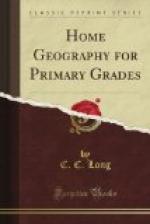Flowers sweet the west wind offers,
Peeping forth from vines and
trees;
Brings the butterflies so brilliant,
And the busy, humming bees.
Each wind brings his own best treasure
To our land from year to year;
Blessings many without measure
E’er attend the winds’
career.
Lillian Cox.
“Whichever way the wind doth blow.
Some heart is glad to have it so;
And blow it east or blow it west,
The wind that blows, that wind is
best.”
Write all that you can tell about the wind.
What was the direction of the wind during the last snow-storm? Why is the north wind cold? Why is the south wind warm?
LESSON VII.
HOW TO TELL DISTANCE.
To tell where a place is, we must know its direction. But this is not all; we must also know how far it is from us; that is; its distance. To find this out we measure.
You have often heard of an inch, a foot, and a yard. This line is one inch long |--------|. Your ruler is twelve inches long, that is a foot. Three lengths of your ruler make a yard. A yard stick is three feet long.
[Illustration: MEASURING SHORT DISTANCES.]
With these measures you can tell how long your slate or your desk is, or how long and wide the schoolroom is.
The inch, foot, and yard are used for measuring short distances. But when we wish to tell the distance between objects far apart, we use another measure called a mile. A mile is much longer than a yard.
Think of some object that is a mile from our schoolhouse. How long would it take you to walk that distance?
[Illustration: MEASURING LONG DISTANCES.]
ORAL EXERCISES.
How many inches long is your slate? How long is your desk? How many feet long is your room? How wide is it? What is the distance around the room? How many feet wide is each window? Each door? How many yards wide is the nearest street or road?
About what is the height of the schoolroom? Of the schoolhouse? Of the tallest tree near by? Of the nearest church spire?
About how long is the longest street in the town where you live? Do you know how many blocks or squares make a mile? Name the nearest river or creek. Give its direction from the school. In what direction does the water run? Give the direction and distance of the nearest church. What must you know to go to any place?
NOTE.—Have pupils estimate distances by the eye, then verify by actual measurement. Continue the exercises until the work becomes quite accurate. Correct ideas of distance are necessary in order to understand how large the world is, and how far apart places are on its surface.




